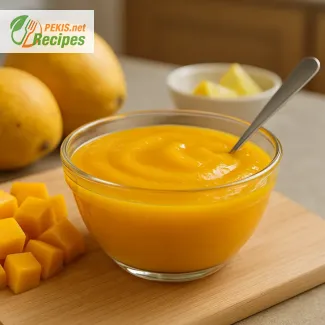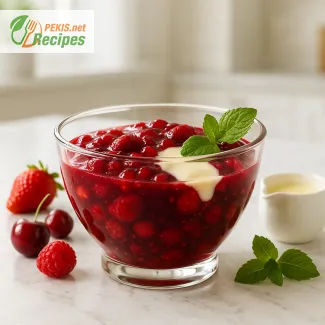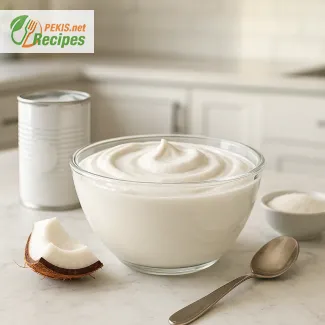
Discover the Freshness of Homemade Mango Puree in Every Spoonful
The tropical secret to quick, healthy desserts and vibrant dishes
When it comes to capturing the essence of tropical fruit in its purest form, few things rival the taste of a perfectly smooth mango puree. Made from ripe, juicy mangoes and nothing more, this golden blend delivers intense flavor, natural sweetness, and a creamy texture that enhances both sweet and savory dishes. Whether you're layering it into a parfait, swirling it into a smoothie bowl, or spooning it over a cheesecake, mango puree offers endless possibilities with minimal effort.
Crafting your own easy mango puree at home means unlocking a level of freshness and quality that store-bought versions often lack. Commercial purees can contain added sugars, preservatives, or artificial flavors that dull the natural vibrancy of real mangoes. In contrast, a homemade version keeps the flavor profile clean, bright, and authentic—exactly what you'd expect from a fruit that thrives in the sun-soaked tropics. And best of all, this recipe comes together in just 5 minutes, making it a favorite for busy weekdays and elegant weekend plating alike.
One of the greatest advantages of making your own mango puree is control. You decide the texture—ultra-smooth for sauces and drinks, or slightly chunky for a rustic topping. You choose the mango variety based on season and sweetness, such as Ataulfo for its buttery smoothness or Kent for its deep honeyed notes. You can even adjust the consistency with a touch of citrus juice or water, depending on how you plan to use it.
The flavor profile of this 5-minute tropical dessert is intensely fruity, naturally sweet, and incredibly versatile. Mango pairs beautifully with a wide range of complementary ingredients: coconut milk for a creamy pudding, lime juice for a tangy sorbet, chili flakes for a bold dipping sauce, or cardamom for a spiced yogurt swirl. The puree can be the foundation of a refreshing mango lassi, the star of a baby food blend, or the elegant garnish for a panna cotta.
In terms of presentation, the vibrant golden-orange color of the puree makes any dish pop. It brings brightness to the plate and instantly communicates freshness and vitality. A swirl of mango puree across a dessert platter or a dollop on a breakfast bowl doesn’t just taste good—it looks spectacular. And because it’s made from just one ingredient, this puree fits beautifully into clean eating plans, plant-based diets, and low-sugar lifestyles.
Why mango puree deserves a permanent place in your kitchen
The simplicity of this mango puree recipe is what makes it so appealing. With just a few fresh mangoes and a blender, you're moments away from something that feels gourmet. It’s the kind of staple that enhances both sweet and savory recipes, while also standing proudly on its own. Unlike more complex preparations, this puree highlights the mango’s natural juiciness and floral aroma—nothing is masked or overcomplicated.
For those who love cooking with fruit or experimenting with global cuisines, mango puree is a game-changer. It's widely used in Indian, Thai, and Caribbean dishes, where it appears in both traditional sweets and contemporary fusions. In Indian cuisine, it forms the heart of aamras, a seasonal delicacy served with puri. In Thai menus, it complements sticky rice desserts, while in the Caribbean, it brightens up jerk marinades and chutneys.
Because of its versatility, this puree can be made in larger batches and frozen for later use. Simply pour it into ice cube trays, freeze, and store in airtight containers. These tropical cubes can be tossed into smoothies, sauces, or drinks at a moment’s notice—making your kitchen feel like a sunny escape no matter the season.
Selecting the right mangoes for the perfect puree
The key to the best homemade mango puree lies in the mango selection. Look for fruit that is heavy for its size, slightly soft to the touch, and emits a fragrant, fruity aroma at the stem. Avoid overly fibrous or under-ripe mangoes, as they can make the puree gritty or bland. Ideally, the mango flesh should be deeply colored, smooth, and yield easily under pressure without being mushy.
If fresh mangoes aren’t in season, you can still create a high-quality puree using frozen mango chunks. Just make sure to thaw them first and drain any excess liquid to maintain a rich texture. In fact, frozen mangoes often work well for consistent flavor, especially if you're blending them into drinks or sauces where visual texture is less important.
Endless ways to use mango puree in your cooking
Once you have a bowl of silky mango puree, the culinary opportunities expand instantly. For breakfast, stir it into oatmeal, layer it in yogurt parfaits, or blend it into smoothies. At lunch, use it as a base for vinaigrettes, drizzle it over grilled chicken or shrimp, or blend it with mustard and vinegar for a mango-infused salad dressing. For dessert, it’s the ultimate topping—pour it over ice cream, cheesecake, pancakes, or use it in a tropical fruit tart.
If you're into baking, try swirling it into cake batters or cheesecakes for natural flavor and color. You can even fold it into whipped cream for a quick mango mousse. Its flavor profile plays beautifully with other tropical fruits like passionfruit, pineapple, and banana—making it ideal for layered desserts or island-inspired dishes.
This easy mango puree recipe is more than just a preparation—it’s a gateway to countless dishes that taste like summer all year round. The taste is bright, the process is fast, and the results are consistently delightful.
- Peel and cut the mangoes: Slice both sides of each mango along the pit. Score the flesh into cubes using a knife, avoiding the skin. Scoop out the cubes with a spoon. You should get about 500 g (1.1 pounds) of mango flesh from 2–3 medium mangoes.
- Blend the mango: Place the mango cubes into a high-speed blender or food processor.
- Add lemon juice: Pour in the lemon juice (15 ml / 1 tbsp) to enhance flavor and preserve the vibrant color of the mango.
- Adjust texture (optional): If the puree is too thick, add a little cold water (30 ml / 2 tbsp) and blend again until you reach the desired consistency.
- Blend until smooth: Process everything until the mango is completely smooth and silky, without chunks or fibers. Scrape down the sides if needed.
- Chill and serve: Transfer the mango puree to a serving bowl or jar. Use immediately, or store in the refrigerator for up to 3 days in an airtight container.
Creative Ways to Enhance Homemade Mango Puree for Versatile Use
Expert tips to elevate flavor, texture, and presentation of a classic mango preparation
Mango puree is already a naturally sweet, vibrant, and refreshing dish that requires minimal effort to prepare. However, like many simple recipes, it leaves plenty of room for creativity and refinement. By thoughtfully adjusting ingredients, preparation techniques, and pairing choices, this traditional recipe can be transformed into a more flavorful, versatile, and health-conscious option. Whether you’re aiming for a deeper mango flavor, a silkier texture, or new culinary applications, small tweaks can make a big impact.
Choosing the right mango varieties for deeper flavor
The foundation of any great mango puree lies in the quality and variety of the mangoes. While most traditional recipes don’t specify a particular type, using a specific mango variety can dramatically influence the final taste and aroma.
- Ataulfo (Honey mango) offers a buttery, ultra-smooth texture and a rich, almost floral sweetness—perfect for a delicate puree.
- Alphonso, known as the “king of mangoes” in India, produces an intensely sweet and fragrant puree ideal for desserts.
- Kent or Keitt mangoes deliver a milder flavor but are available for longer parts of the year, offering a more consistent result.
- Avoid fibrous varieties like Tommy Atkins if you're aiming for an ultra-smooth puree.
By selecting mangoes with the right ripeness and texture, you ensure your puree is sweet, vibrant, and free of grainy bits that can compromise the experience.
Adding citrus or herbs to enhance complexity
While lemon juice is traditionally used in mango puree to brighten flavor and maintain color, there are more nuanced ways to boost the overall taste profile.
- A touch of lime juice instead of lemon introduces a sharper, more exotic acidity that cuts through the natural sweetness.
- Adding a pinch of lime zest can further intensify the aroma.
- Fresh mint leaves or basil blended into the puree can add a cooling, herbaceous contrast that elevates the dish from basic to gourmet.
- For a warm finish, a dash of ground cardamom or cinnamon can transform the puree into an aromatic delight, perfect for fall or winter pairings.
These ingredients don’t just add flavor—they create new layers of complexity that make the puree more memorable and sophisticated.
Upgrading texture with coconut cream or Greek yogurt
For a creamier version of mango puree that works beautifully as a standalone dessert, you can add:
- Coconut cream (30–50 ml) for a rich, tropical profile and velvety finish.
- Full-fat Greek yogurt (2–3 tablespoons) to add tang, body, and protein, making it suitable for breakfast bowls or a healthier dessert.
Both additions transform the consistency of the puree from light and juicy to creamy and decadent. Coconut cream enhances the tropical note, while Greek yogurt balances the sweetness and adds nutritional value.
Sweetness balance and natural alternatives
Depending on the ripeness of the mangoes, the puree might need a touch of added sweetness—especially if the fruit is slightly underripe or acidic. Instead of using refined sugar, opt for:
- Agave syrup or maple syrup for mild, earthy sweetness.
- Honey for floral undertones (keep in mind it's not vegan).
- Stevia or erythritol, if you're aiming for a sugar-free option.
Adding sweeteners should always be done gradually and to taste, as mangoes naturally vary in their sugar content.
Avoiding common mistakes when making mango puree
Even the simplest recipes have potential pitfalls. Avoiding these common mistakes ensures your mango puree is always silky and bursting with flavor:
- Using underripe or overripe mangoes: The former leads to tart, bland puree; the latter results in fermentation-like flavors. Choose mangoes that yield slightly to pressure and have a rich aroma.
- Skipping straining: Even the best blenders may leave fibrous strands. Use a fine mesh sieve for a flawless texture.
- Over-blending with water: Adding too much water dilutes flavor and makes the puree runny. Use water only if necessary, and in small increments.
Healthier twists for different dietary goals
This already light recipe can be adjusted further to suit specific health-conscious diets:
- For a low-glycemic option, blend in chia seeds and let the puree sit—this thickens it naturally while adding fiber and omega-3s.
- To increase fiber and antioxidants, blend in berries like raspberries or blueberries. This also gives a beautiful color twist.
- For a protein-rich version, mix with silken tofu or plant-based protein powder, making it ideal as a post-workout snack.
Storage, freezing, and long-term use
Homemade mango puree can be made in bulk and stored for future use. These are the best practices for maintaining freshness and quality:
- Store in airtight glass jars in the fridge for up to 3–4 days.
- Freeze in ice cube trays for portion control. Use frozen cubes for smoothies, sauces, or baby food.
- For long-term storage, consider vacuum-sealing and freezing for up to 3 months.
Avoid plastic containers if possible, as mango puree can stain and retain odors. Glass preserves the flavor and color better over time.
Expanding culinary applications beyond dessert
While mango puree is often viewed as a dessert ingredient, it can play a key role in savory dishes and international recipes:
- Combine it with chili flakes and soy sauce for a spicy-sweet dipping sauce or marinade.
- Use it as a base for tropical vinaigrettes, blended with olive oil and vinegar.
- Add a touch of ginger and garlic for a Caribbean-inspired glaze for grilled meat or tofu.
- Mix it with mustard for a mango mustard spread that’s perfect for sandwiches or cheese platters.
By stepping beyond traditional usage, this puree becomes a culinary bridge between cultures and cuisines.
Elevating the mango puree experience
Transforming a basic mango puree into something extraordinary doesn't require complicated techniques—just a refined approach to ingredients and thoughtful enhancements. Whether you're adjusting for health goals, elevating for special occasions, or expanding into savory applications, this humble recipe has the versatility to shine in countless ways. With the right ingredients and a bit of inspiration, your mango puree will become more than just a base—it will be a signature element in your kitchen repertoire.
- This recipe is naturally gluten-free and contains no common allergens.
- Substitution tips: If citrus is a concern (due to lemon juice), you can substitute it with apple cider vinegar in the same quantity (15 ml / 1 tbsp) or omit it entirely for a milder flavor.
- Vitamin C: 45 mg (50% DV) – supports the immune system and collagen production
- Vitamin A: 1,080 IU (22% DV) – essential for eye health and skin renewal
- Vitamin E: 0.9 mg (6% DV) – helps protect cells from oxidative stress
- Potassium: 260 mg (7% DV) – supports heart health and fluid balance
- Folate: 23 mcg (6% DV) – supports cell function and tissue growth
- Beta-carotene: 640 mcg – supports skin health and boosts immune defense
- Mangiferin: approx. 45 mg – has anti-inflammatory and blood sugar regulating effects
- Polyphenols: approx. 110 mg – contribute to cardiovascular and cellular health
- Quercetin: trace amounts – supports anti-allergic and anti-inflammatory responses





